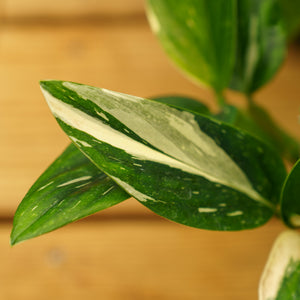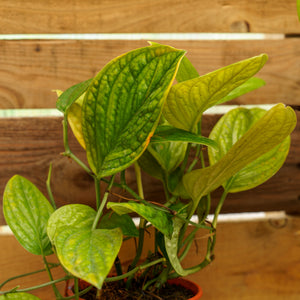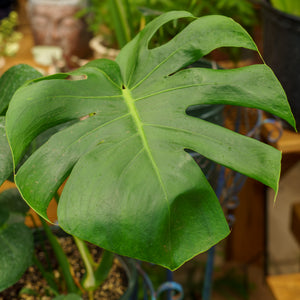The Monstera Guide
Monstera, often referred to as the “Swiss Cheese Plant,” is a beloved houseplant genus known for its bold foliage and natural architectural flair. With iconic leaves full of fenestrations and unique textures, monstera varieties are as stunning as they are diverse. Native to the tropical rainforests of Central and South America, these aroids add lush, jungle-like character to indoor spaces, making them a favorite among plant collectors and casual growers alike.
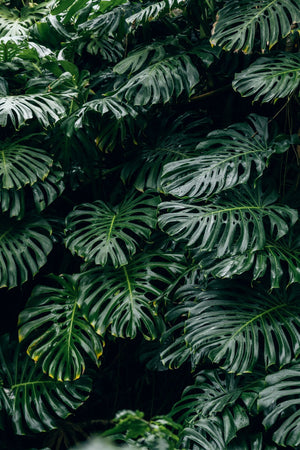
About
The Monstera genus includes several popular species, each with its own visual appeal and growing habits:
- Monstera deliciosa is the most iconic, with large, deeply lobed leaves that develop natural holes as they mature. The popular cultivar ‘Thai Constellation’ adds creamy variegation to this dramatic silhouette.
- Monstera standleyana 'Albo Variegata' features narrow, lance-shaped leaves with streaks of white or cream.
- Monstera karstenianum (sometimes sold under the name Philodendron sp. Peru) has thick, textured leaves without fenestrations, offering a bold look in a compact form.
- Monstera epipremnoides, often confused with other species, produces dramatic split foliage similar to M. deliciosa but with a thinner and more delicate leaf texture.
All monstera species are climbing or vining plants that benefit from support structures such as moss poles, trellises, or coco totems. In their natural environment, they use aerial roots to cling to trees and reach for the canopy.
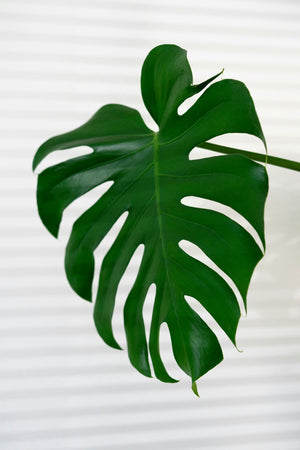
PLANTING
While not planted outdoors in most climates, monsteras thrive indoors with proper light and soil conditions:
- USDA Hardiness Zones: Suitable for outdoor planting only in Zones 10–12. Commonly grown as houseplants in all other regions.
- Soil: Use a chunky, well-draining potting mix rich in organic matter. A blend of potting soil, orchid bark, perlite, and peat or coco coir is ideal.
- Light: Bright, indirect light is best. Avoid harsh direct sunlight, which can scorch leaves, and low-light areas, which can stunt growth.
- Container: Choose a pot with drainage holes. Repot every 1–2 years as the plant outgrows its space.
- Support: Insert a moss pole or stake early on to encourage upright growth and larger leaf development.
Monstera should be positioned where they have room to expand both vertically and laterally—especially larger varieties like M. deliciosa.
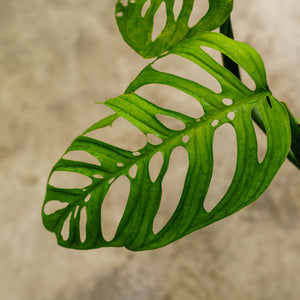
CARE
Caring for monstera is straightforward with the right conditions. These tropical plants appreciate warmth, humidity, and space to climb:
- Watering: Water when the top 2–3 inches of soil feel dry. Inconsistent watering can cause browning leaf edges or root rot. Always empty excess water from saucers.
- Humidity: Prefers moderate to high humidity (50%+). Use a humidifier or pebble tray, especially in dry indoor environments.
- Fertilizing: Feed monthly during spring and summer with a balanced, water-soluble fertilizer. Reduce or pause feeding in fall and winter.
- Pruning: Remove yellowing or damaged leaves as needed. Prune vines to control size or shape, always cutting just above a node.
- Cleaning: Wipe leaves with a damp cloth to remove dust and promote efficient photosynthesis.
Aerial roots may appear on stems—these are natural and can either be left alone, guided into moss poles, or trimmed back if unruly.
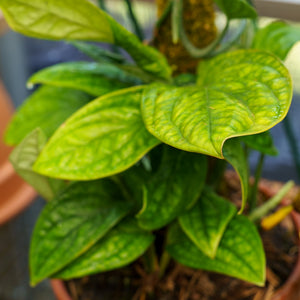
HOW TO USE
Monstera can serve as a dramatic interior focal point or blend into a broader indoor plant collection:
- Focal Point: Large M. deliciosa or ‘Thai Constellation’ can anchor living rooms, home offices, or entryways with bold tropical style.
- Bookshelf Accent: More compact species like M. karstenianum work well on shelves or side tables.
- Hanging Basket or Shelf Edge: Juvenile monsteras can trail down from elevated spots until they begin to climb.
- Statement Corner: Combine monstera with complementary tropicals like philodendrons, pothos, and bird of paradise for a lush, cohesive look.
Choose decorative pots that contrast with the plant’s leaf shape and color, or use neutral tones to let the foliage shine.
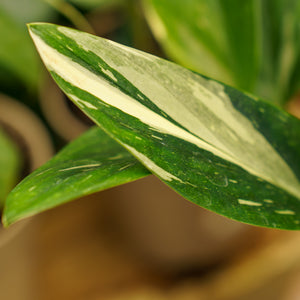
COMMON QUESTIONS
- How to propagate monstera? Take a stem cutting with at least one node and leaf. Root in water or moist soil until roots are a few inches long, then transplant.
- Are monstera toxic to cats? Yes, all parts of monstera contain insoluble calcium oxalates and are toxic to cats if ingested.
- Are monstera toxic to dogs? Yes, they are toxic to dogs and may cause drooling, vomiting, or oral irritation.
- How often to water monstera? Water when the top 2–3 inches of soil are dry. Frequency varies with season, pot size, and humidity.
- How to care for monstera? Provide bright indirect light, humidity, consistent watering, and occasional feeding. Support vertical growth with a pole or trellis.
- How to prune monstera? Prune to manage size or remove dead foliage. Cut just above a node or growth point for best results.
Conclusion
Monstera is a must-have plant for those looking to add bold, tropical character to their interiors. Whether you prefer the classic form of M. deliciosa or the rare beauty of ‘Thai Constellation’, monstera plants reward you with architectural foliage, adaptability, and a striking presence. With the right care and environment, they can grow into towering houseplants that transform indoor spaces with their lush, green energy.
The Monstera Collection
Sold Out
Sold Out

